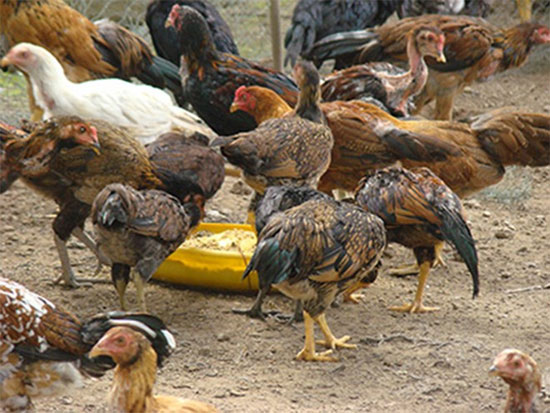Breeding hybrid chickens according to biological model
Kien Giang Center for Agricultural and Fishery Extension (KNK) has cooperated with technical and economic groups and farmers to develop a model of hybrid chicken raising in biosafety with a total of 3,000 animals.
The model is implemented in 2 districts of Chau Thanh, An Bien and Ha Tien Town from May 2014. 15 households tested and applied the method of net-enclosure in combination with gardening to reduce the cost of feed investment. Participating farmers were supported 60% of seed money and 30% of food costs by Kien Giang KNKN Center.

Breeding chicken breeds in the direction of biosecurity in Kien Giang.
According to engineer Le Thi Count - Head of Agricultural Extension Department, Kien Giang Agriculture and Rural Development Center - households use industrial feed in the first stage (in cages), after moving to garden and feeding with rice. In the process of raising, there has been no epidemic so far due to proper implementation of procedures and vaccination schedule. Results in some initial culture sites showed that the ratio of live chickens reached 96%, when finishing (2.5 - 3 months of age), the average size of the chickens was 1.4 - 1.5kg / head. Estimated after deducting costs, each household raised VND 3.2 million.
Mr. Nguyen Van Thom - living in Xeo Ro hamlet, Hung Yen commune, An Bien district - said that the first step shows that raising hybrid chickens in the direction of biosafety is easy to raise and adapt to the environment. Herds of chickens were raised for the first time (200 animals), her family collected nearly 6 million VND in interest. Realizing that raising hybrid chickens in the direction of biosecurity is easy to raise, economic efficiency is quite high, many farmers continue to raise the second batch with the number of times more than the first.
According to engineer Le Thi Count, this model uses Balasa in environmental treatment. Normal farming as usual, if not using this product, farmers must replace the padding within 2-3 weeks because the cage will smell bad smell. When using Balasa in the pad, nearly 3 months still do not need to change the pad, but do not see the smell. Using Balasa also reduces costs because there is no need to change the pad frequently.
- Nghe An expanded to raise biological safety chickens
- Bac Kan: Testing the model of chicken raising on hills
- Excellent hybrid children
- The technique of raising chickens in our gardens is highly effective
- Create crocodile hybrid chicken
- The hybrid car 'hybrid' smartphone
- Phu Tho produces chicken breeds by artificial insemination
- The shocking truths about little chickens think of
- Discover embryos in eggs, dinosaurs are revived?
- Breeding chickens to produce electricity
- An Giang successfully completed the chicken ship breeding
- Tien Giang applied scientific and technological advances to animal husbandry
 'Barefoot engineer' invents a pipeless pump
'Barefoot engineer' invents a pipeless pump Process of handling dead pigs due to disease
Process of handling dead pigs due to disease Radiometer
Radiometer Warp Engine: Technology brings us closer to the speed of light
Warp Engine: Technology brings us closer to the speed of light